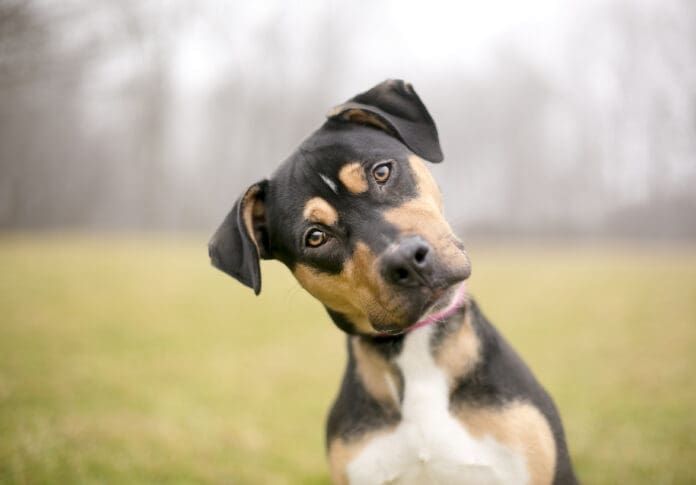Asking for a dog to pay attention by calling her name is one of the most commonly used cues in everyday life with our canine companions. That makes it easy to teach, even by accident. Most dogs will figure out their names eventually even without being specifically taught because it is repeated and reinforced so often. Call your dog’s name when it’s time for dinner or a walk and she will quickly learn that her name means it’s time to check in to see if something good is happening. That said, you can speed the process up a lot by learning how to teach a dog her name.
Do Dogs Know Their Names?
As young children, humans learn by repetition (saying the name over and over again) and reinforcement (providing feedback when the baby responds) that their names refer to them as individuals. In a broad sense, the same is true for how dogs learn their names. However, what names mean to them is likely quite different.
For humans, a name is part of our identity, providing a series of sounds that refer to a specific individual. Just imagine what it would be like trying to navigate human society without a name. Though the communication barrier prevents us from asking, observations of dog behavior suggest that dogs respond to names more like any other learned cue.
As best we can tell, dogs identify individuals (both human and canine) primarily by smell, sight, and sound. Even if a dog never learns her humans’ names—though many do—the smell of a familiar person or the sound of a known voice will set her tail to wagging. A dog knows and remembers individuals by these characteristics first and only learns a word for that individual, such as a name, if there is a benefit to doing so. Therefore, if you want her to respond to such a word, you will need to teach her.
How To Teach A Dog Her Name
Before you begin teaching your dog her name, pick the exact name you are going to use to ask for your dog’s attention (see the sidebar below regarding nicknames). From there:
- Get some treats your dog really likes and find a quiet spot with as few distractions as possible.
- With your dog standing or sitting close to you, say her name in an upbeat, excited voice.
- When your dog looks at you, give her the treat. You can also use rewards such as toys, praise, or cuddles.
- Repeat 10-15 times.
- Practice several times a day until she begins to look at you as soon as you say her name.
Once your dog is reliably responding to her name when she is near you, you can begin increasing the distance between you. From 5 feet away, repeat the steps above. When she is looking at you reliably from 5 feet, move to 10 feet, and so on. Remember, this is not a ‘stay’. It’s okay, even desirable, if she moves toward you when you say her name.
When your dog is regularly looking at you when you say her name from anywhere in a quiet, distraction free room, you can move to a slightly busier location and start the process again. You’ll want to begin with her close to you and add distance once you’re sure she’s still responding well.
Once busier locations pose no problem, you can start adding distractions such as tossing a toy right before saying her name or having another person walk into the room. If she starts losing focus at any point in the process, back up a step and practice closer and with fewer distractions for a few days before trying again.
Common Mistakes to Avoid
There are a few mistakes that are easy to make but best avoided if you want your dog to learn and respond to her name quickly. These include:
- Saying a dog’s name in anger or frustration: It’s extremely tempting to use a dog’s name when she has done something naughty. However, if she comes to associate her name with unpleasantness—even if it’s only that you are upset—she will be much more likely to either ignore it or leave when she hears it rather than turning her attention to you.
- Saying a dog’s name repeatedly without reinforcement: Especially in the early stages of teaching a dog her name, it is important to provide positive reinforcement whenever she hears her name and responds. Failing to do so can turn it into just another word she hears that doesn’t mean anything special.
- Using nicknames or variations of a name: While nicknames aren’t a bad thing, they can be confusing for a dog. For example, if you start teaching your new dog to pay attention when you say ‘Harriet’, but also call her ‘Harry’ and ‘Princess’ expecting her to respond the same way, it’s going to take longer to teach her that all of those sounds mean you want her attention. You are essentially asking her to learn multiple cues for one behavior at the same time, which will likely slow down the learning process.
Changing Names
Many dogs come to their new homes having already been given names. Rescues and shelters regularly name the dogs they are entrusted with and many breeders name their puppies. When it comes time for the dog to relocate to a forever home, her new family will often want to change the name she came with. I’ve been asked more than once if that is a hardship for the dog.
In my experience, it is perfectly fine to switch a dog’s name. Even if she knows and responds to the old one, think of it as asking her to learn a new cue. The trick is to teach the new name with joy and affection so she associates it with great things.
All of my dogs have nicknames. It just seems to happen. They come into the family, a name is decided on, and next thing I know the dog is being called several things that may or may not have anything to do with the original name. So how do I avoid confusing my dogs?
It’s pretty simple, actually. Nicknames are for downtime. Each dog has one name that is used for when I want their attention. That name is what I call them during training, mealtimes, and any other time I need them to look at me. I treat that name like a cue that only gets used when I want a specific behavior and am prepared to reinforce it.
By contrast, nicknames are casual. I usually use them during playtime, talking to the dogs (which happens a lot), or while discussing the dogs with other people. My dogs have tended to get the idea eventually, but I don’t expect or need a response to a nickname and I don’t actively reinforce it. In short, don’t hold back on the nicknames but be sure to decide ahead of time what you want your dog’s ‘real’ name to be!







Good article thx for the tips and the clear sequences described